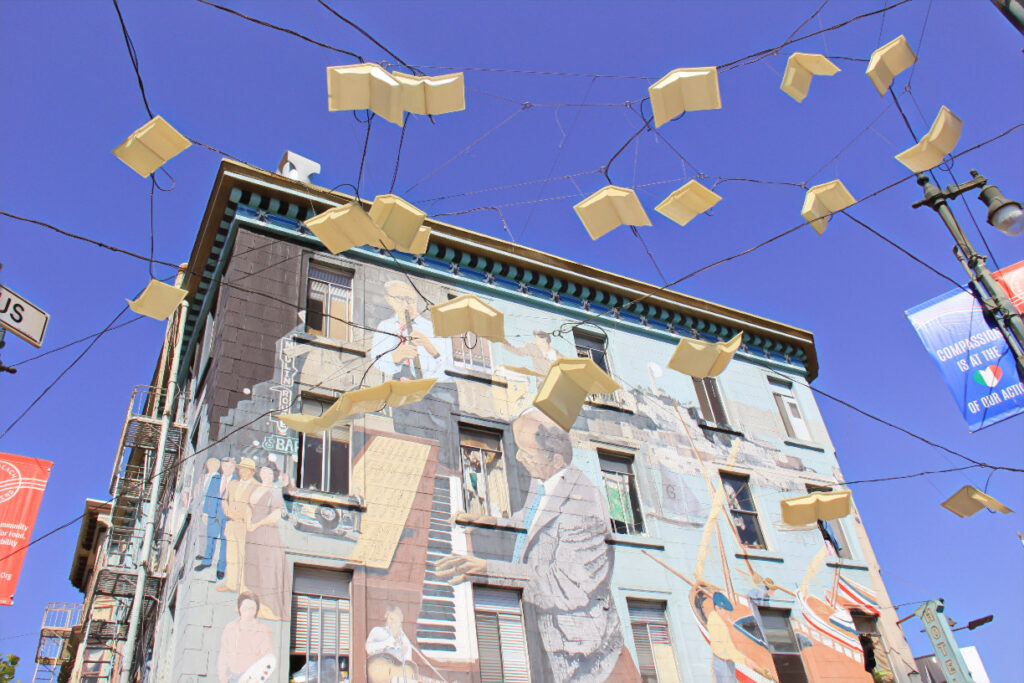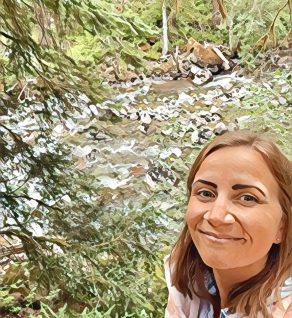With such rich literary history, there are dozens of literary sites in San Francisco to visit on your next trip. This list was hard to create, as I am leaving out some incredible places (and people) that have touched the literary world of the City by the Bay. But if I had to narrow it down to a top ten list, this is it!
THE 10 BEST LITERARY SITES IN SAN FRANCISCO
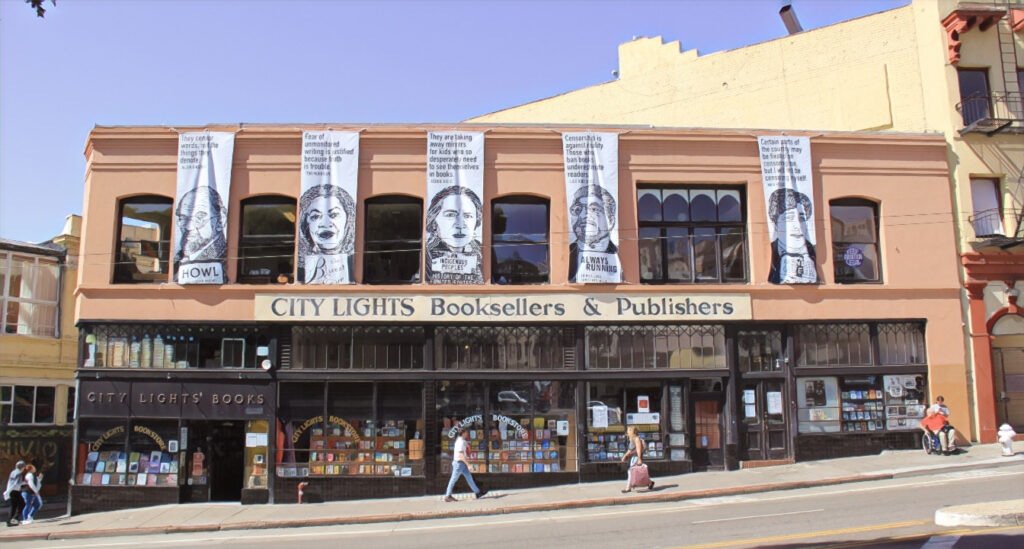
City Lights Bookstore
261 Columbus Ave.
Beloved as one of the country’s best bookstores for decades, City Lights Bookstore had more of a humble beginning than one might think. It was the brainchild of Peter D. Martin who was using the name City Lights (a tribute to the 1931 Charlie Chaplin Film) for a magazine he was publishing. Lawrence Ferlinghetti was a contributor. Martin wanted to open an all paperback bookstore, as paperbacks were hard to come by (typically only found on spinning racks at drug stores) and not taken seriously.
By chance meeting one evening, Ferlinghetti spotted Martin hanging up a “Pocket Book Shop” sign and a partnership was born with each of them investing $500 into the store. In 1955, Martin sold his shares for $1000 and moved back to New York City.
The original shop only occupied only a small portion of the triangular Artigues building at 261 Columbus Avenue. The building itself was erected in 1907 and built over ruins from the 1906 earthquake. Over time, the store began to acquire more space as other businesses moved and eventually took over the entire building.
In 2023, City Lights celebrated its 70th anniversary as a treasured bookstore and publishing house. If you can only visit one bookstore while in San Francisco, this is the one!
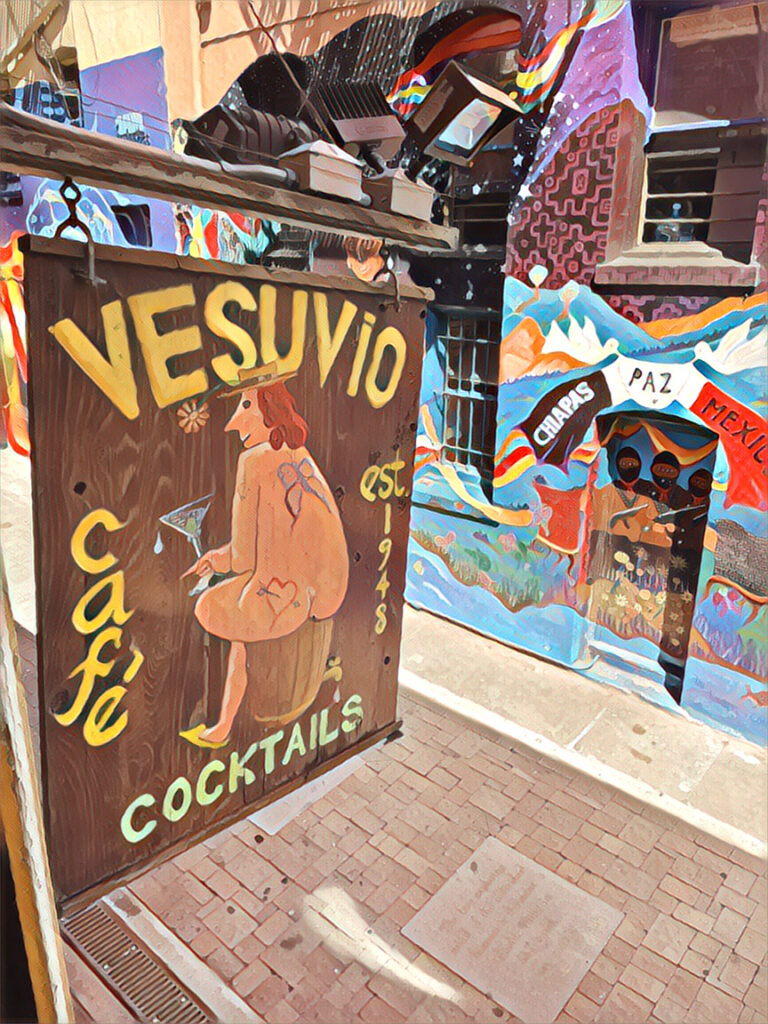
Vesuvio Café
255 Columbus Ave.
There is no Beat Generation pilgrimage to San Francisco without a stop for libations at Vesuvio Cafe (adjacent to City Lights Bookstore). What opened as a bar in North Beach in 1948 transformed into a hub for beat writers, poets, and musicians as it became more frequented by Neal Cassidy, Jack Kerouac, Allen Ginsberg, and Lawrence Ferlinghetti. On a night in 1960, Kerouac was supposed to be trekking down to Big Sur to meet Henry Miller and instead spent the night bellied up to the bar calling Miller every hour to continue delaying his arrival. He never would make the trip that night.
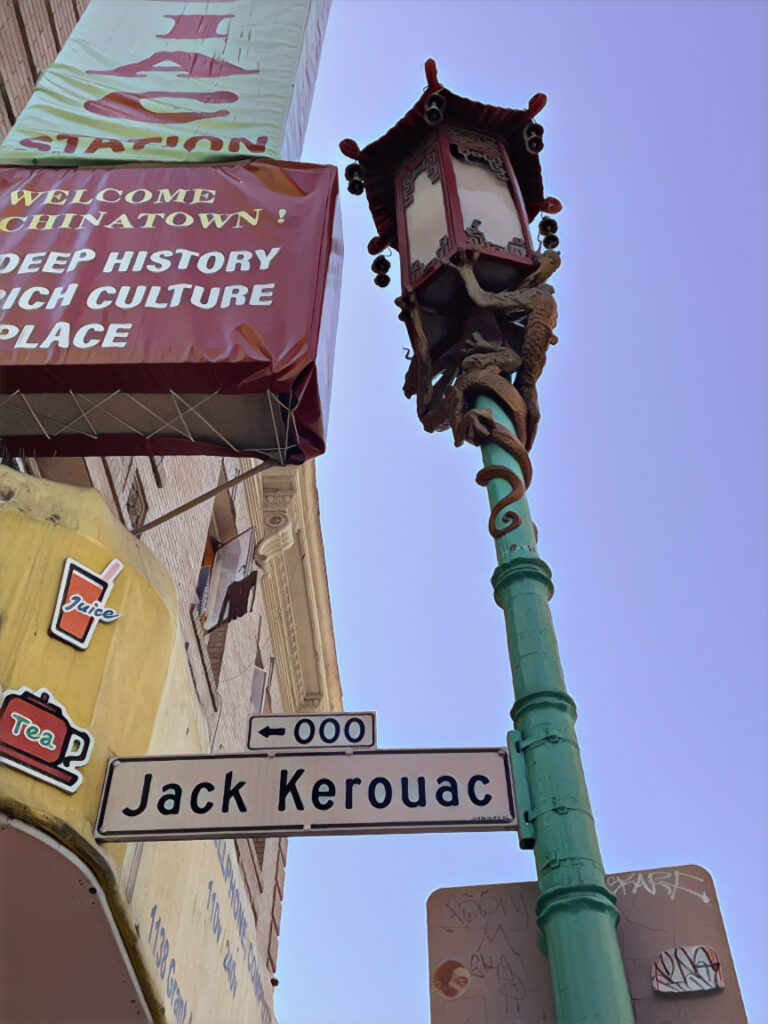
Jack Kerouac Alley
Between City Lights and Vesuvio Café
Originally known as Adler Place or Adler Alley, the pedestrian walkway between City Lights Bookstore and Vesuvio Café is named after the iconic Beat writer, Jack Kerouac. He was a frequent consumer of both establishments, of course. In the 1980s the owner of City Lights and fellow Beat contemporary, Lawrence Ferlinghetti, pushed to have a handful of San Francisco’s streets named after authors and this swath became officially known as Jack Kerouac Alley in 1988. The alley was slightly widened, repaved and made pedestrian only in 2007.
A uniqueness of this alley is that is binds together two incredibly cultural neighborhoods in the city–North Beach and Chinatown. As you walk the alley from Columbus Ave. you’ll see author’s quotes embedded into the ground. In the center of the alley there is a circular Jack Kerouac and as soon as you cross over that you’ll notice that the author’s quotes begin to include Chinese characters as well. You’re now closer to Chinatown than you are to North Beach and once you reach the western end of the alley you’re standing on Grant Ave. in Chinatown. A true example of East meeting West.
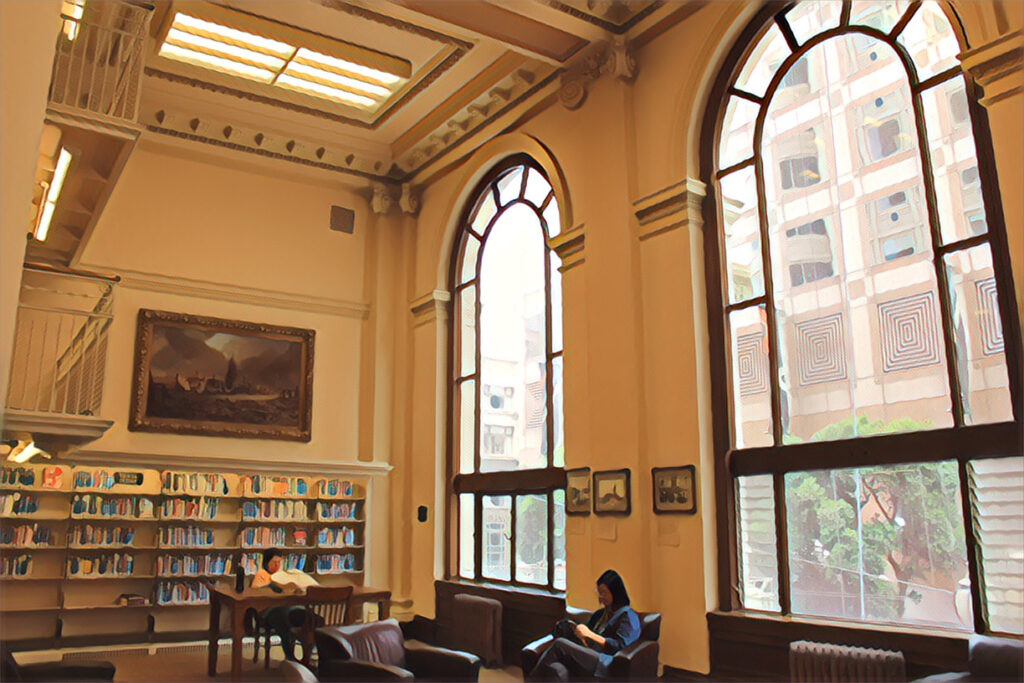
Mechanics Institute Library
57 Post Street
Tucked in an unassuming (though beautiful) building in the financial district, the Mechanics Institute Library has been offering its membership services since 1854 when out-of-work gold miners needed vocational training and a collection of educational resources. Throughout the years, the library’s collection has shifted from a vocational focus to one that embraces the social sciences.
Today, you’ll find both nonfiction and fiction books, a small children’s section, newspapers and periodicals, magazines, and an assortment of DVDs and CDs. The institute is also home to the oldest continuously operating chess club in the United States. While the library is only available to its fee paying members, it offers a weekly free tour of the building and collection on Wednesdays.
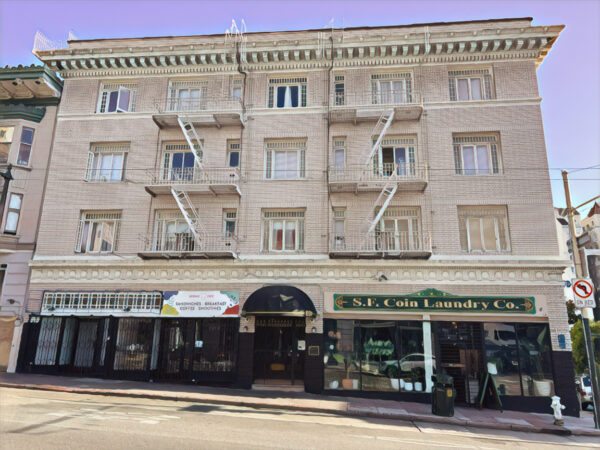
Dashiell Hammett’s Apartment
891 Post Street #401
The father of San Francisco noir, Dashiell Hammett, wrote his first novels Red Harvest (1929), The Dain Curse (1929), and what is considered to be his most prolific work, The Maltese Falcon (1930) when he lived at this address in the Tenderloin neighborhood from 1926 to 1929. Was this also the dwelling of his most memorable protagonist, Sam Spade?
While there’s no hard evidence to back this claim, most conclude that Spade’s apartment was based on Hammett’s that was positioned on the northwest corner of the fourth floor, unit 401.
The literary landmark plaque was erected in 2005 by the San Francisco Chronicle branch of Friends of Libraries USA.
Please note: The Tenderloin neighborhood is an area of San Francisco where the fentanyl crisis is especially apparent. Please be aware.

Jack London Birthplace Plaque
Third Street and Brannan (on the Wells Fargo Building)
Jack London was an Oakland boy and spent the later years of his life deep within the Sonoma Valley in a little hamlet called Glen Ellen but he was born on this site on January 12, 1876. Born John Griffith Chaney, he came into the world in a humble home that stood here, then known as 615 Third Street. Unfortunately, the home was destroyed by the fires caused by the devastating 1906 earthquake.
A simple plaque, marking the birthplace of one of the most celebrated writers of the 20th Century was placed here in 1953 by the California Historical Society.
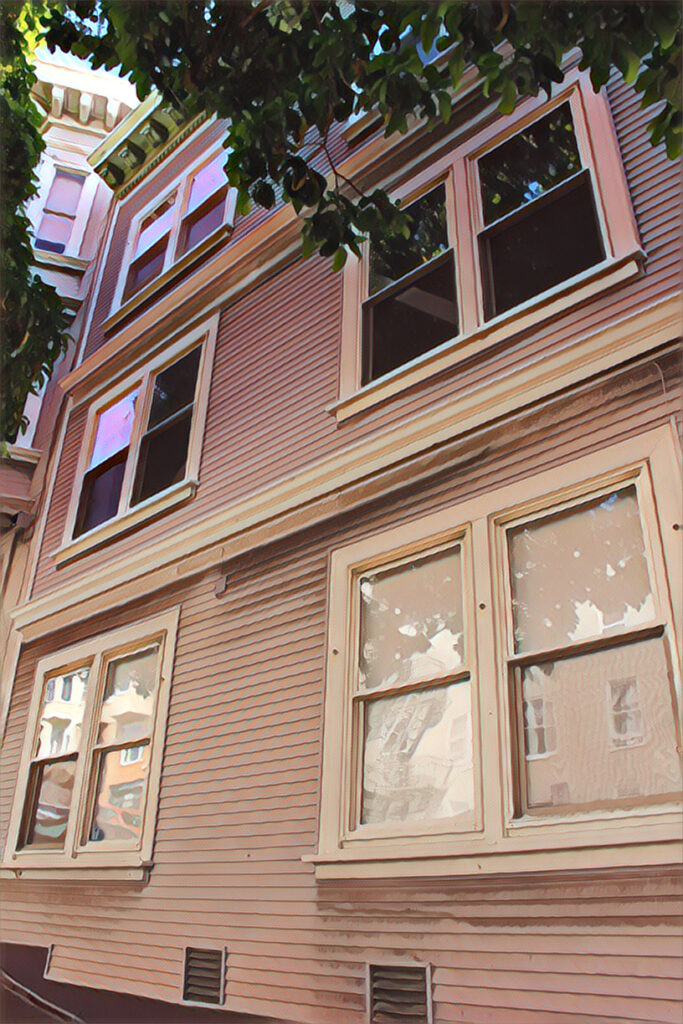
Allen Ginsberg’s Apartment
1010 Montgomery Street
In the summer of 1955, Allen Ginsberg was sharing an apartment with fellow poet (and eventual long-time partner) Peter Orolovsky on Montgomery Street just to the east of the North Beach neighborhood. His front room held a victrola, letters and Essays of Ezra Pound, books, and a watercolor portrait of Ginsberg in his army-surplus jacket by Robert La Vigne. It was here that he spent the summer writing Howl Part 1, a poem that would bring fame and an obscenity case in court following the poem being published by Lawrence Ferlinghetti.
By that time people across the country knew who Allen Ginsberg was and what Howl was all about, the trial ended in a ruling in Ginsberg’s favor. Imagine writing a poem in this nondescript apartment flat laid that would lay part of the foundation of what would become the Beat Generation’s identity.
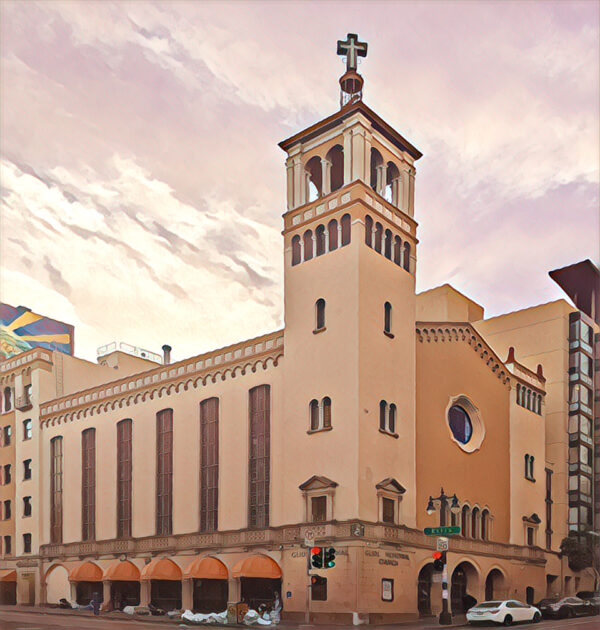
Maya Angelou’s Memorial Service
Glide Memorial Church, 330 Ellis Street
The streets of San Francisco were Maya Angelou’s stomping ground. It was here that she worked as one of the first Black woman streetcar operators. She graduated high school and worked as a performer in nightclubs–where she officially tried on the name Maya Angelou for size for the first time.
Maya Angelou spent so much of her life in the Bay Area that she requested her memorial service to be held at Glide Memorial Church in the Tenderloin neighborhood. While crowds gathered outside on a summer day in 2014, those close to her such as Oprah Winfrey, Michelle Obama, and Bill Clinton reflected on her life and legacy within the church, where she had been a longtime member.
Please note: The Tenderloin neighborhood is an area of San Francisco where the fentanyl crisis is especially apparent. Please be aware.
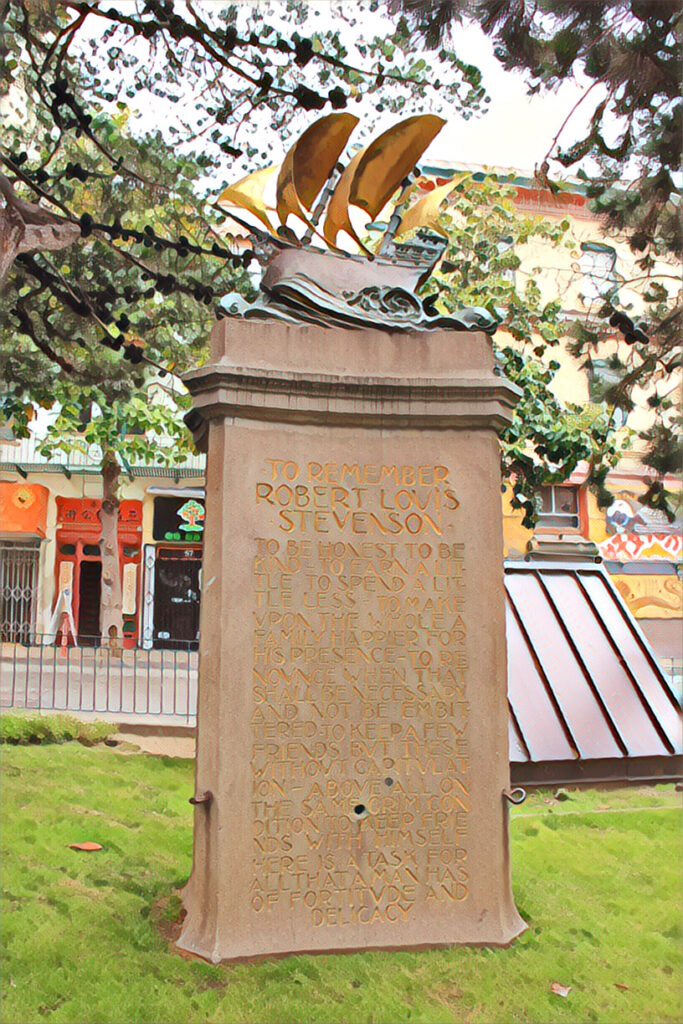
Robert Louis Stevenson Memorial
Portsmouth Square, 745 Kearny Street
Often sickly, Robert Louis Stevenson would walk over to Portsmouth Square on sunny days for doses of vitamin D and fresh air. The park was just a quarter of a mile to the northwest of his apartment on Bush Street. In 1897, a memorial was erected for him.
The inscription is from chapter 12 of Across the Plains, A Christmas Sermon (the book he wrote about his journey across America).
It reads: To Remember Robert Louis Stevenson–to be honest, to be kind – to earn a little, to spend a little less – to make upon the whole a family happier for his presence – to renounce when that shall be necessary, and not be embittered – to keep a few friends but these without capitulation – above all on the same grim condition to keep friends with himself – here is a task for all that a man has of fortitude and delicacy.
The memorial was designed by architect Willis Polk along with sculptor Bruce Porter (who also both created the Filoli Estate in nearby Woodside, CA).
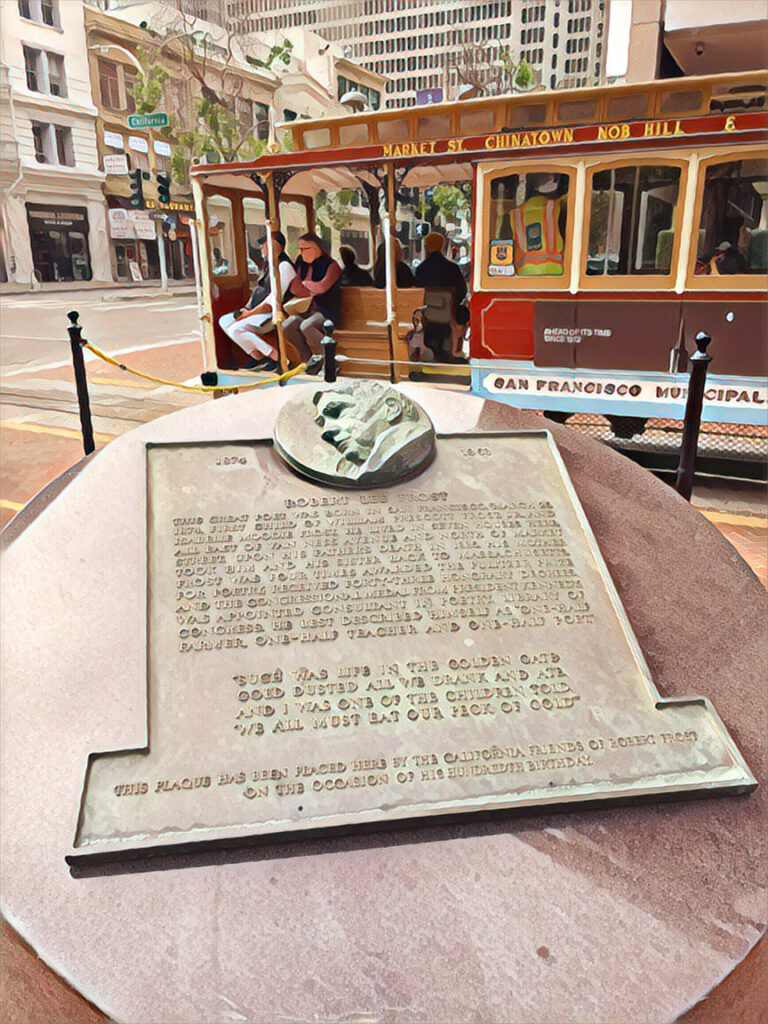
Robert Frost Plaque
Market and Drumm Streets
So often we associate Robert Frost as the New Englander who lived and wrote poems in Massachusetts. But it was here in San Francisco that he was born on March 26, 1874 to William Prescott Frost Jr. and Isabelle Moodie. The family moved frequently and Frost lived in seven different locations in the City by the Bay all east of Van Ness and north of Market Streets before his father died in 1885. After his father’s death, Frost’s mother moved the family to Lawrence, Massachusetts.
Find this plaque adjacent to the Hyatt Regency near the Embarcadero on Market Street where it meets Drumm Street. It’s right where the cable car reverses its course so if you find that first, you cannot miss the plaque. The Frost quote reads:
“Such was life in the Golden Gate:
Gold dusted all we drank and ate,
And I was one of the children told,
‘We all must eat our peck of gold.’”
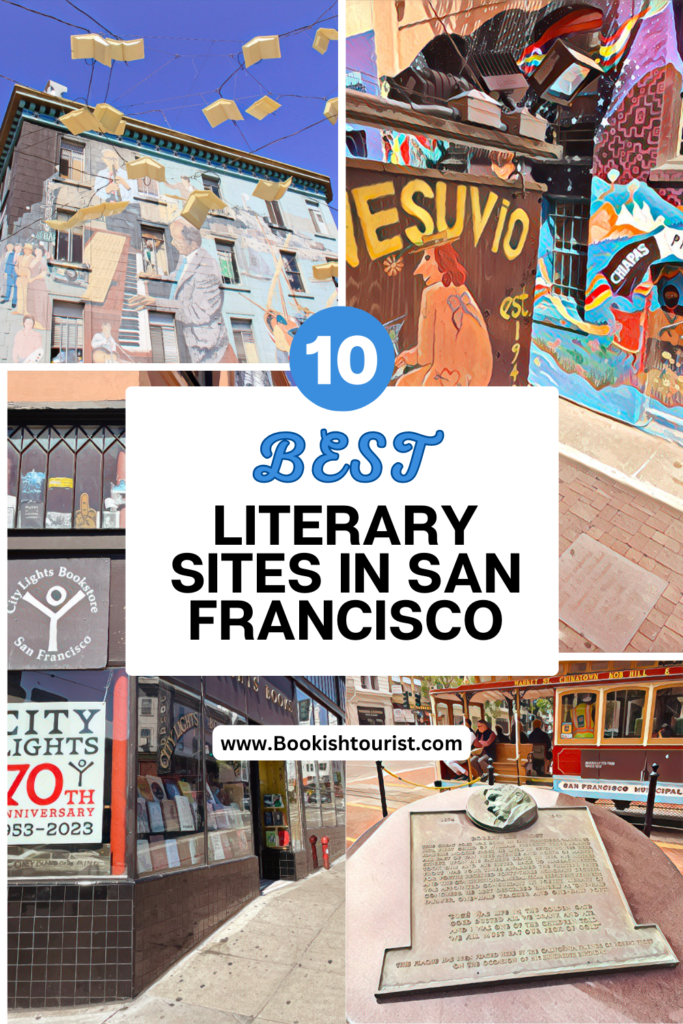
That’s the 10 Best Literary Sites in San Francisco! Think I missed something major? Let me know in the comments.
